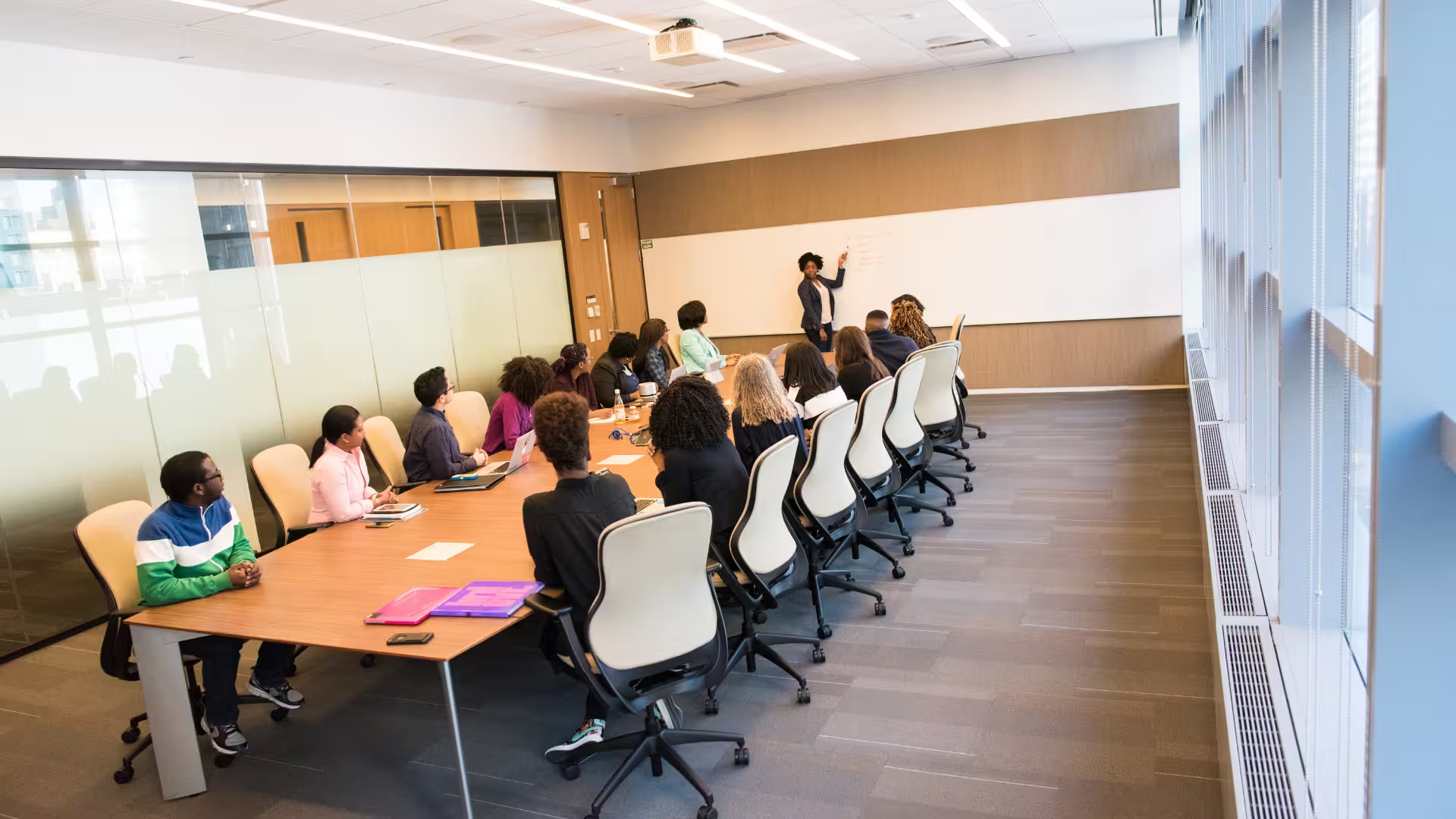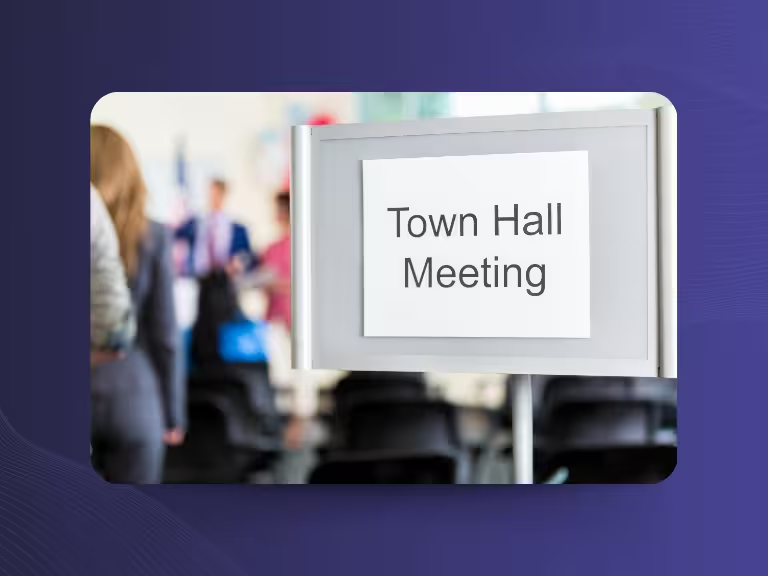Table of Contents
Understanding the Importance of Townhall Meetings
A townhall meeting serves as a bridge between leaders and their communities or employees, creating space for open dialogue and transparent communication. Whether it's a local government addressing residents' concerns or a company CEO updating staff on quarterly results, these gatherings play a crucial role in building trust and alignment.
In today's digital age, townhall meetings have evolved beyond traditional face-to-face gatherings. Virtual townhalls are becoming increasingly popular, offering greater accessibility and reach while maintaining the interactive elements that make these meetings effective. The growing emphasis on inclusive dialogue means organizations must carefully consider how they structure these events to ensure all voices are heard.
This article explores the different types of townhall meetings, provides practical guidance for organizing effective sessions, shares strategies for maximizing engagement, and addresses common challenges that arise in both community and corporate settings.
What Is a Townhall Meeting? Definition, Types, and Purpose
Defining the Townhall Meeting
At its core, a townhall meeting is a forum where leaders engage directly with their constituents or employees in an open, interactive setting. Unlike one-way presentations, these meetings emphasize two-way communication, allowing participants to ask questions, share concerns, and provide feedback in real-time.
Community townhalls typically focus on local government issues, urban planning, or civic concerns. Residents might discuss traffic problems, school funding, or upcoming municipal projects. Corporate townhall meetings, on the other hand, center around company performance, strategic initiatives, policy changes, and employee concerns.
A typical agenda includes status updates, strategic announcements, and dedicated Q&A sessions. Interactive elements like live polling or breakout discussions are increasingly common, especially in virtual formats.
Purpose and Goals of Townhall Meetings
The primary purpose of any townhall meeting is fostering transparency and trust between leadership and participants. When done effectively, these meetings create a sense of shared ownership and collective responsibility for outcomes.
Two-way communication stands as the hallmark of successful townhalls. Leaders share important information while simultaneously gathering valuable feedback and insights from their audience. This exchange helps align everyone around common goals and ensures that decisions reflect the needs and concerns of those affected.
For organizations, townhall meetings serve as powerful tools for change management. They provide a platform for addressing concerns, clarifying misconceptions, and building support for new initiatives. The participative nature of these meetings often leads to better decision-making and stronger buy-in from participants.
Organizing and Structuring an Effective Townhall Meeting
Planning Your Townhall: Step-by-Step Guide
Successful townhall meetings begin with clear objectives. Are you communicating major changes, gathering feedback on a specific issue, or building team morale? Your objectives will shape every other planning decision.
Format selection depends on your audience and goals. In-person meetings offer the most natural interaction but limit attendance to those who can physically attend. Virtual townhalls can accommodate larger, geographically dispersed audiences but require more sophisticated engagement strategies. Hybrid formats combine the best of both worlds, though they demand careful technical coordination.
Timing matters significantly. Schedule meetings when your target audience is most likely to attend. For corporate settings, avoid busy periods like month-end or during major project deadlines. Community townhalls often work best in the early evening when working residents can participate.
Promotion should be multi-channel and begin well in advance. Use email, internal communication platforms, social media, and even traditional media for community events. Clear communication about the agenda, expected duration, and participation methods helps set appropriate expectations.

Crafting the Meeting Agenda and Content
A well-structured agenda typically opens with brief introductions and ground rules, followed by key updates or announcements. The heart of most townhalls is the interactive portion where participants can engage directly with leadership.
Interactive elements transform passive listeners into active participants. Live polling can gauge opinion on specific topics, while breakout discussions in smaller groups encourage more intimate dialogue. Anonymous question submission tools help shy participants contribute and can reveal concerns that might otherwise remain hidden.
Preparing moderators and speakers is crucial for maintaining flow and managing difficult moments. They should be briefed on potential sensitive topics and equipped with strategies for handling conflict or dominating voices respectfully but firmly.
Leveraging Technology for Virtual Townhalls
Popular platforms like Zoom, Microsoft Teams, and Google Meet each offer unique features for townhall meetings. Zoom's breakout rooms work well for small group discussions, while Teams integrates seamlessly with other Microsoft workplace tools. The choice often depends on your organization's existing technology infrastructure.
Engagement tools become even more critical in virtual settings. Live polls, chat functions, and real-time Q&A features help maintain energy and participation. Language translation and closed captioning support inclusive participation for diverse audiences.
Technical rehearsals are non-negotiable for virtual townhalls. Test all features, have backup plans for common issues, and ensure all speakers are comfortable with the technology. Tools like Sally can help by automatically recording and transcribing sessions, allowing organizers to focus on facilitation rather than documentation.
Maximizing Participation and Engagement
Strategies for Organizers to Enhance Interaction
Creating an environment where people feel comfortable speaking up requires intentional effort. Start by establishing clear ground rules that encourage respectful dialogue while preventing any single person from dominating the conversation.
Open Q&A sessions work best when facilitated actively. Consider collecting questions in advance and during the meeting through multiple channels. Anonymous submission options often yield more honest and direct feedback, especially on sensitive topics.
Reaching out to diverse and underrepresented groups requires proactive effort. This might mean scheduling separate sessions for different time zones, providing childcare for community meetings, or ensuring translation services are available. The goal is removing barriers that prevent participation.
Managing dominant voices while encouraging participation from quieter members requires skilled moderation. Techniques include time limits for individual contributions, rotating speaking opportunities, and directly inviting input from specific groups or individuals.
Tips for Participants: How to Make the Most of a Townhall Meeting
Participants can maximize their townhall experience by preparing in advance. Think about questions or topics you'd like to address, and consider how to frame them constructively. Research background information on agenda items to contribute meaningfully to discussions.
Active listening is just as important as speaking. Pay attention to others' concerns and questions, as they often reveal issues you hadn't considered. This broader perspective helps build empathy and understanding across different viewpoints.
Take advantage of anonymity options when they're available. These tools can help you raise sensitive issues or provide honest feedback without fear of repercussions. Many organizations gather their most valuable insights through anonymous channels.
Follow-up engagement extends the meeting's impact. Provide additional feedback after the session, participate in surveys, and engage with action items that emerge from the discussion.

Additional Insights: Challenges, Cultural Differences, and Follow-Up
Common Challenges and How to Overcome Them
Disengagement often stems from meetings that feel one-sided or irrelevant to participants' concerns. Combat this by ensuring agenda items directly relate to audience interests and by creating multiple opportunities for interaction throughout the session.
Technical issues can derail virtual townhalls quickly. Preparation is key: test all systems beforehand, have technical support readily available, and prepare backup communication methods. When issues do arise, address them quickly and transparently.
Balancing transparency with confidentiality requires careful planning. Clearly communicate what topics are open for discussion and which are restricted. When you can't share certain information, explain why rather than simply deflecting questions.
Cultural Variations in Townhall Meetings
Communication styles vary significantly across cultures, affecting how people participate in townhall meetings. While direct questioning of authority figures is common in U.S. business culture, it may be less comfortable in hierarchical societies where respect for leadership is expressed differently.
Adapting meeting etiquette to cultural norms improves participation and comfort levels. This might mean allowing more time for responses, using different formats for question submission, or adjusting the level of formality in discussions.
Multilingual support and accessibility features demonstrate genuine commitment to inclusion. Consider providing interpreters, translated materials, and culturally appropriate communication styles to ensure everyone can participate meaningfully.
Ensuring Diversity and Inclusion
Creating safe spaces for marginalized voices requires intentional design. This might involve separate sessions for different groups, anonymous feedback mechanisms, or structured opportunities for underrepresented perspectives to be heard.
Accessibility accommodations should be standard practice, not special exceptions. Closed captioning, sign language interpretation, and accessible venue selection ensure that physical or sensory limitations don't prevent participation.
Diverse perspectives enrich discussions and lead to better outcomes. Actively seek input from different departments, demographic groups, and experience levels rather than relying on the same voices to speak up repeatedly.
Effective Follow-Up Mechanisms
Prompt communication of meeting summaries and key takeaways demonstrates respect for participants' time and input. Share these within 24-48 hours while the discussion is still fresh in everyone's mind.
Action plans should clearly connect feedback to specific next steps. When suggestions can't be implemented, explain why. This transparency builds trust and encourages continued participation in future meetings.
Surveys and feedback collection help improve future townhall meetings. Ask specific questions about format, content, and engagement level. Use this data to refine your approach continuously.
Maintaining transparent feedback loops closes the communication circle. Regular updates on progress toward goals discussed in townhalls show that these meetings drive real change rather than serving as mere information sessions.
The Enduring Value of Townhall Meetings
Townhall meetings remain powerful tools for building transparency, engagement, and shared understanding within organizations and communities. Their effectiveness depends heavily on thoughtful planning, inclusive practices, and robust follow-up mechanisms that demonstrate genuine commitment to dialogue and action.
The evolution toward virtual and hybrid formats has expanded the reach and accessibility of these meetings while introducing new challenges and opportunities. Organizations that embrace both traditional and digital approaches can create more inclusive and effective communication channels.
Modern tools like Sally can streamline the administrative aspects of townhall meetings by automatically handling recording, transcription, and documentation tasks. This technological support allows organizers to focus on what matters most: facilitating meaningful dialogue and building stronger relationships.
Ultimately, successful townhall meetings empower communities and organizations to grow stronger through open, honest conversation. They create space for different perspectives to be heard, concerns to be addressed, and collective solutions to emerge. In an era of increasing complexity and change, these forums for direct dialogue become even more valuable for building understanding and driving positive outcomes.

Try meeting transcription now!
Experience how effortless meeting notes can be – try Sally free for 4 weeks.
Test NowOr: Arrange a Demo Appointment

.avif)



